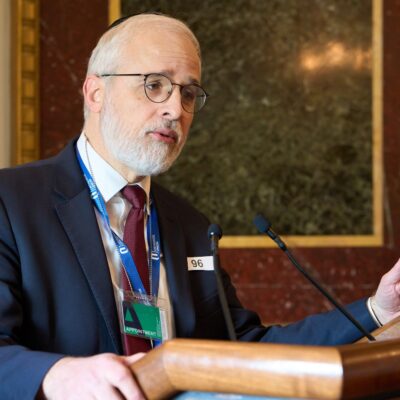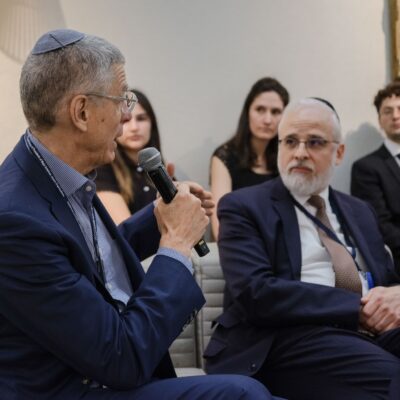Opinion
Bigger faster stronger
Branch Out: The benefits of regional staff and centers
In Short
Increased reach, nimbleness, and opportunities for collaboration are just a few reasons organizations are choosing to move to or expand their regional model.
Over the last few years, many grantee-partners of the Jim Joseph Foundation have created or expanded regional operations. The impetus or approach varied from one organization to the next, but in each case they and the Foundation recognized the potential benefits of a regional structure.
When we asked grantee-partners to share their rationale for using or expanding their regional structure, as well any challenges they experienced in the process and positive outcomes they have observed since making the shift, several themes emerged.

Rabbi Avi Strausberg, Hadar Institute's director of national learning initiatives, at Hadar's DC yom iyyun (day of Torah learning). Photo courtesy of Hadar Institute.
Design to Meet Demand
When the Hadar Institute opens a new regional office, it’s because there is both broader demand for its style and approach to learning and a critical mass of people asking Hadar to invest in their city, says Hadar President and CEO Rabbi Elie Kaunfer.
“One of our main goals is to collaborate, not compete, with the institutions that are already there. Hadar spends months speaking to people on the ground— experts in the local community and organizational leaders, so it can be additive to the Jewish community.”
One of the challenges of regional expansion is that Hadar initially sends a small team, often only one person, and they end up being a mini-start up in the context of a larger organization. “That is why we look for candidates with entrepreneurial energy,” says Rabbi Kaufner. “Our directors are educators-slash-rabbis, which allows for learning to happen throughout the year.”
“Unsurprisingly, people feel a closer connection to Hadar when there is a local presence, and they end up participating in a broader array of Hadar’s offerings beyond their local programs. They are also more likely to invest in the organization when the organization invests in them. And of course, our regional directors can forge deeper relationships with people since they are a real part of these communities and not swooping in as visitors.”
Visions of Strategic Reach, Increased Effectiveness and Internal Accountability
Organizations like Moving Traditions and Keshet use regional offices and staff to better reach people they want to support.
Keshet’s strategy for geographic expansion focuses on states with significant Jewish populations and anti-LGBTQ+ political climates. “We opened an office in Florida two years ago and in Texas earlier this summer, resulting in an outpouring of energy and interest to get involved with Keshet,” says President and CEO Idit Klein. “At a time of unprecedented legal assaults on LGBTQ+ people, particularly transgender youth, local leaders are eager to send the message that in the Jewish community, our LGBTQ+ community members are seen, loved, and cherished.”
Moving Traditions added a Southern Director “to help bring programs to places like Florida and Texas where Jewish teens — particularly LGBTQ+ teens — could really use the circles of support that our programs provide,” says CEO Shuli Karkowsky.
But that addition is part of a larger vision. “As Moving Traditions seeks to double the number of Jewish youth we engage in our programs by 2025, it made sense to think bigger,” says Karkowsky. “We are no longer targeting key cities – we’re targeting North America. Having regional directors working from home offices throughout the United States enables us to build community and relationships, to better serve our partners, and to introduce more teens and parents alike to Moving Traditions’ suite of programs.”
Repair the World moved into a regional programmatic and development structure in 2022 to provide greater support and accountability across its Repair communities. They also had an eye on cost savings to ensure it uses funding and support strategically. They hired regional directors who provide executive leadership, coaching, and organizational guidance to a group of Repair communities, and regional development directors, who hold relationships with the local lay and professional leadership to focus on sustaining local giving and bringing new individual and institutional partners to support Repair communities.
“We’ve learned from our peers and seen over the past year that the regional model strengthens consistency across our programming, fosters increased collaboration across communities in the same region, and provides more opportunities for staff and fellows to come together to learn and connect,” says Repair the World Chief Strategy Officer Kate O’Bannon. “The added support also frees up local leadership to focus on the service and Jewish learning programming, since much of the fundraising responsibility and some relationship building has been transferred to the regional team.
“To set up this model for success, we ensured the hiring process for the regional roles tested which candidates could demonstrate a clear ability to learn new landscapes quickly and build relationships in a remote environment. We have also committed to building local advisory councils of lay leaders in each community to support Repair’s local programs. A year into the rollout of this model, we have seen qualitative and quantitative evidence that the model is on a pathway to success, and know that the added support for strong connections between programming and development is key to this success.”
A Need For Speed
Other organizations find that regional offices enable their efforts to innovate, quickly mobilize, and build a culture of collaboration.
“Our regional strategy has been an important element in our ability to remain nimble, understand and address needs of local camps, and accelerate innovation through different pilots in different regions,” says Jeremy J. Fingerman, CEO of Foundation for Jewish Camp.
FJC’s West Coast region, for example, has been working collectively with California camps to explore options for property insurance, for which the premiums have skyrocketed. In the Southeast, FJC piloted a partnership with Hillel to help camps recruit and retain counselors and to help Hillels identify and afford much-needed additional year-round staff members; and regional offices in LA and Chicago played a critical role in engaging local funding support in response to the pandemic.
Hillel International has also been utilizing regional collaboration as a tool for innovation and support. As part of Hillel’s Campus Support Directors, a program funded by The Marcus Foundation, the executives of seven Florida Hillels regularly share information related to fundraising and advancement; craft joint reporting on multiple Federation grants; and share staff training, onboarding and information about prospective students.
“I convene these executive directors every three weeks to discuss topics that range from creating sustainability through endowment and legacy campaigns, to the specifics of staff supervision,” says Debbie Pine, campus support director at Hillel International. “Although the campuses and the Hillels themselves are quite different, because of the coordination and support from Hillel International and the close working relationships they have built, these Florida Hillel executive directors describe this group as their most important cohort of colleagues.”
“Over the past few years, we have run in-state and travel programs for students at all Florida campuses, brought board chairs and executive directors together to share lessons learned and explore collaborations, and confronted antisemitism across campuses in a coordinated, strategic way,” she says.
Physical offices still serve a purpose
From the perspective of Riki Robinson, program director of the New York Hub of the Jews of Color Initiative (JoCI) opening a brick and mortar office in New York “solidified our footprint in a region with a large Jews of Color (JoC) presence and has woven us into local culture, communities, and events.” The New York Hub has proven to be an impactful pilot for JoC in the region and for JoCI organizationally, she says.
One challenge, however, is that regionally-specific offices and programs can limit who they serve. “For example, our Incubator was restricted to those in the Greater New York area, though we saw many instances where the program could benefit leaders outside of the region,” she says.
Investing in a physical office space also runs against the current workforce trend toward more work-from-home and hybrid workplace environments. “While our offices weren’t always used, they did create a valuable physical address for co-working teams, programs, and community engagement,” she says.
The common link in all these examples is that each organization saw a reason, aligned with its mission and audience engagement goals, to deploy a regional approach. Careful planning and hiring were instrumental in making these ventures successful. Certainly other aspects were part of the “how” as well, and the Jim Joseph Foundation is happy to connect anyone interested in learning more about a specific regional model to the appropriate organization highlighted here. By sharing best practices and insights, more organizations will be able to bring meaningful Jewish learning and engagement experiences to people around the country.
The Jim Joseph Foundation works to foster compelling, effective Jewish learning experiences for young Jews.

 Add EJP on Google
Add EJP on Google








